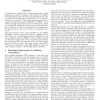Free Online Productivity Tools
i2Speak
i2Symbol
i2OCR
iTex2Img
iWeb2Print
iWeb2Shot
i2Type
iPdf2Split
iPdf2Merge
i2Bopomofo
i2Arabic
i2Style
i2Image
i2PDF
iLatex2Rtf
Sci2ools
COLING
2000
2000
A Model of Competence for Corpus-Based Machine Translation
A translation is a conversion from a source language into a target language preserving the meaning. A huge number of techniques and computational approaches have been experimented in order to translate natural languages automatically, yet no satisfactory solution has been found. This paper examines approaches to corpus-based machine translation (CBMT). In CBMT, a set of reference example translations is given to the MT system. These are analyzed and compiled into the system's internal representation according to the theory of meaning the system implements. The representations, then, serve as a basis to translate new sentences. This paper discusses three main approaches in the CBMT paradigm: the memory-based approach (e.g. translation memories (TM)), the example-based approach (EBMT) and the statistical-based approach (SBMT). Concrete CBMT systems are discussed in light of the theory of meaning (preservation) they implement. This discussion, then leads to a model of competence for...
Related Content
| Added | 01 Nov 2010 |
| Updated | 01 Nov 2010 |
| Type | Conference |
| Year | 2000 |
| Where | COLING |
| Authors | Michael Carl |
Comments (0)

